What does OSIA mean in UNCLASSIFIED
OSIA stands for Open Standards Identity APIs. It is a set of standards and specifications that define how identity data and services are accessed and managed in a secure and interoperable manner. OSIA provides a common framework for developing identity management systems that can be used by a wide range of applications and services.

OSIA meaning in Unclassified in Miscellaneous
OSIA mostly used in an acronym Unclassified in Category Miscellaneous that means Open Standards Identity APIs
Shorthand: OSIA,
Full Form: Open Standards Identity APIs
For more information of "Open Standards Identity APIs", see the section below.
What is OSIA?
OSIA is a set of specifications that define how identity data and services are accessed and managed. These specifications include:
- A data model that defines the structure of identity data
- An API that defines how identity data and services can be accessed
- A security model that defines how identity data is protected
OSIA is based on the principle of open standards. This means that the specifications are public and freely available. Anyone can use OSIA to develop identity management systems.
Benefits of OSIA
OSIA provides a number of benefits, including:
- Interoperability: OSIA-compliant systems can interoperate with each other, regardless of the vendor or technology used.
- Security: OSIA provides a strong security framework that protects identity data from unauthorized access.
- Flexibility: OSIA is flexible enough to accommodate a wide range of identity management needs.
Essential Questions and Answers on Open Standards Identity APIs in "MISCELLANEOUS»UNFILED"
What is OSIA?
Open Standards Identity APIs (OSIA) is a set of open-source APIs for identity management and authentication. It provides a standards-based approach to building and integrating identity systems across different platforms and applications.
Why use OSIA?
OSIA offers several benefits, including:
- Interoperability: OSIA-compliant systems can communicate and exchange identity information seamlessly.
- Extensibility: OSIA is designed to be extensible, allowing developers to add new features and integrate with third-party services.
- Security: OSIA incorporates industry-standard security protocols to protect user data and prevent unauthorized access.
What are the main features of OSIA?
OSIA provides a comprehensive set of features for identity management, including:
- Authentication: OSIA supports multiple authentication methods, including password, OAuth, and biometrics.
- Authorization: OSIA enables fine-grained authorization based on roles, permissions, and other attributes.
- Provisioning: OSIA allows for the creation, modification, and deletion of user accounts and profiles.
- Federation: OSIA facilitates the integration of multiple identity systems into a single, federated platform.
How is OSIA implemented?
OSIA is typically implemented as a middleware layer between applications and identity providers. It can be deployed on-premises or in the cloud, and supports a variety of programming languages and platforms.
What are the benefits of using OSIA in my organization?
Organizations that adopt OSIA can benefit from:
- Reduced costs: OSIA's open-source nature eliminates licensing fees and reduces the cost of identity management.
- Increased efficiency: OSIA streamlines identity management processes and improves operational efficiency.
- Improved security: OSIA's standards-based approach and security features enhance the protection of user data and prevent unauthorized access.
Final Words: OSIA is a valuable set of standards for developing identity management systems. It provides a common framework for interoperability, security, and flexibility. OSIA-compliant systems can be used by a wide range of applications and services, making it an important part of the identity management landscape.
